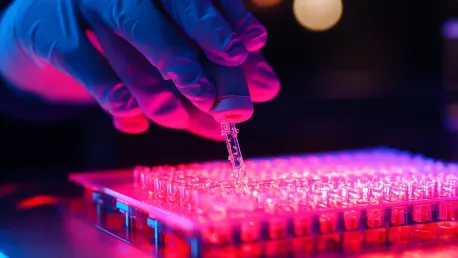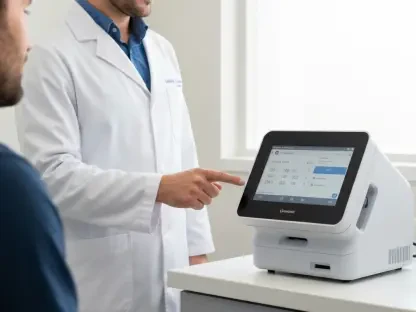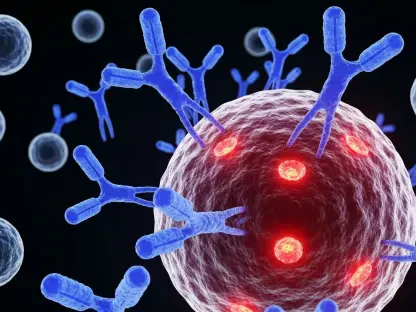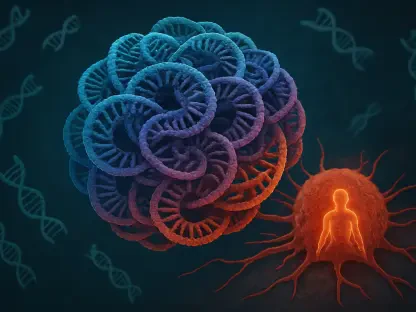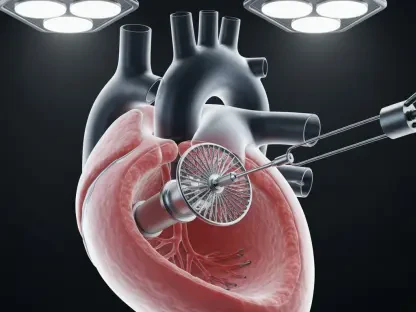The integration of CRISPR technology with biomaterials engineering offers a promising avenue for safer and more effective gene therapies. Tomas Gonzalez-Fernandez, an assistant professor at Lehigh University, has received funding from the National Science Foundation’s Faculty Early Career Development Program (CAREER) for this innovative research. This award reflects a commitment to exploring advanced therapeutic possibilities by combining synthetic biology, biomaterials, and tissue engineering.
The Promise and Challenges of CRISPR Technology
Understanding CRISPR’s Potential
CRISPR, an acronym for Clustered Regularly Interspaced Short Palindromic Repeats, is a revolutionary gene-editing tool with the potential to treat a myriad of genetic disorders by enabling precise modifications to DNA. This tool can cut, replace, or delete specific mutations and can also modulate gene expression to either amplify or diminish the effects of certain genes. Its versatility and power make CRISPR a cornerstone of modern genetic therapy. By allowing scientists to target specific genetic sequences, CRISPR has provided unique opportunities for therapeutic innovations that were previously unimaginable.
However, despite its promise, CRISPR technology comes with its own set of challenges. One major difficulty is ensuring the accuracy of gene edits, as unintended modifications could potentially harm patients by inducing unwanted mutations or by affecting non-target genes. Moreover, with current delivery methods, CRISPR can sometimes interact with untargeted portions of the genome, leading to off-target effects and potential deleterious consequences. As a result, refining the targeting precision of CRISPR is crucial for its safe and widespread application in genetic therapies.
In Vivo Application Challenges
Despite its potential, the application of CRISPR in vivo—directly within a patient—presents significant challenges. When administered as a systemic injection, CRISPR circulates throughout the body, often causing unintended and adverse effects on non-target tissues. This systemic distribution poses a major hurdle in ensuring the safety and efficacy of CRISPR-based therapies. Additionally, the immune system can sometimes mount a reaction to the gene-editing components, complicating the therapeutic process and potentially reducing the effectiveness of the treatment.
Addressing these challenges requires innovative strategies to enhance the precision and control of CRISPR delivery. One promising approach involves the use of advanced biomaterials to localize and modulate CRISPR activity. Biomaterials can potentially serve as carriers that release CRISPR components in a controlled manner, reducing the risks associated with non-specific distribution and immune responses. By leveraging the properties of these materials, researchers aim to make gene therapy safer and more targeted, opening the door to treating a broader array of genetic disorders with greater confidence and success.
Innovative Approach: Combining CRISPR with Biomaterials
Targeted Delivery with Hydrogels
Gonzalez-Fernandez’s research aims to address these challenges by combining CRISPR with biomaterials to control its delivery and action more precisely. His approach seeks to mitigate the potential risks associated with systemic distribution and improve the targeting of specific tissues. This innovative strategy leverages hydrogels—crosslinked polymer networks that can hold a large amount of water relative to their dry mass—as vehicles to guide the CRISPR complexes to the desired cellular targets. Hydrogels offer an attractive option due to their biocompatibility, ability to be engineered with specific properties, and capacity to release therapeutic agents in a controlled manner.
The choice of hydrogels as delivery vehicles is based on their unique ability to encapsulate CRISPR components and release them over time at the intended site of action. By tuning the physical and chemical properties of hydrogels, researchers can ensure that CRISPR is delivered efficiently to targeted cells, minimizing exposure to non-target tissues and reducing the likelihood of off-target effects. This approach aims to harness the advantages of hydrogels in localized delivery, improving the safety profile of gene therapies.
Engineering Hydrogels for Optimal Delivery
The fundamental hypothesis guiding this research is that hydrogels can be engineered to optimize the spatial and temporal delivery of CRISPR, making gene therapies not only safer but also more efficacious. Through meticulous laboratory experiments, Gonzalez-Fernandez and his team will initially investigate the interaction between CRISPR and various hydrogels. They aim to understand how different properties of hydrogels, such as charge and porosity, affect the efficiency and accuracy of CRISPR delivery. This detailed examination will shed light on the key parameters that influence CRISPR performance, enabling the design of more effective delivery systems.
By systematically testing a range of hydrogel formulations, the research aims to identify the optimal conditions for CRISPR delivery. These experiments will explore how various hydrogel characteristics impact the release kinetics of CRISPR components, ensuring that gene-editing activity is localized and sustained at the target site. The goal is to develop hydrogel-based systems that provide controlled, precise delivery, enhancing the therapeutic outcomes of CRISPR-based treatments and minimizing the risks associated with systemic exposure.
Laboratory and Cellular Studies
Preliminary Laboratory Experiments
Following these preliminary studies, the research will progress to examining how these biomaterial-CRISPR complexes interact with human cells. This step is crucial because the behavior of CRISPR in conjunction with biomaterials in a cellular environment will provide deeper insights into improving gene-editing efficiency and minimizing collateral damage to non-target cells. By exploring these relationships, the research strives to identify the optimal conditions under which CRISPR can be effectively utilized for therapeutic purposes. Detailed studies on cellular uptake, distribution, and gene-editing activity will inform the design of next-generation biomaterial carriers for CRISPR.
In addition to understanding the interplay between hydrogels and CRISPR, these cellular studies will also investigate the immune responses elicited by the biomaterial-CRISPR complexes. Reducing immunogenicity is paramount for ensuring patient safety and long-term viability of gene therapies. By analyzing cellular immune reactions and fine-tuning the hydrogel properties, researchers aim to develop delivery systems that are not only efficient but also biocompatible, promoting the acceptance and functionality of CRISPR within living tissues.
Pioneering Research in Biomaterials and CRISPR
One significant aspect of this research is its pioneering nature. According to Gonzalez-Fernandez, there has been minimal investigation into the potential for biomaterials to enhance CRISPR delivery. This investigation is one of the first to delve into how biomaterial properties and cellular interactions collectively influence the efficacy of gene-editing tools like CRISPR. By venturing into this relatively unexplored territory, the research could pave the way for novel therapeutic advancements that capitalize on the synergy between biomaterials and gene-editing technologies.
The exploration of biomaterials for CRISPR delivery represents a bold step toward overcoming current limitations in gene therapy. By combining the expertise in biomaterials engineering with cutting-edge genetic tools, the research promises to yield new insights and approaches that could transform the landscape of genetic medicine. This innovative endeavor aims to set the stage for the next generation of gene therapies, characterized by enhanced safety, precision, and therapeutic potential.
Long-Term Objectives and Clinical Implications
Developing Safer Therapeutics
The long-term objective of this research is to create therapeutics that are not only more efficient but also safer for treating various genetic diseases. These include, but are not limited to, cancer, sickle cell anemia, cystic fibrosis, Alzheimer’s disease, Duchenne muscular dystrophy (DMD), and other chronic musculoskeletal disorders. This endeavor is especially pertinent given the recent successes and setbacks in the clinical application of CRISPR. By developing safer and more reliable gene-editing methods, the research seeks to expand the range of treatable conditions and improve patient outcomes across diverse medical fields.
The ultimate goal is to translate these scientific advancements into clinical practice, bringing tangible benefits to patients. By ensuring that CRISPR-based therapies can be administered with higher precision and safety, the research has the potential to increase the accessibility and efficacy of gene-editing treatments. The findings from this investigation could inform the design of clinical protocols and regulatory guidelines, facilitating the approval and adoption of novel therapeutic approaches that harness the power of CRISPR.
Addressing Clinical Challenges
For instance, the FDA has recently approved CRISPR-based therapy for treating sickle cell disease. This groundbreaking treatment involved editing patient cells ex vivo—which means outside the body—before reintroducing them back into the patient, resulting in a remarkable success story for sickle cell anemia. However, this method requires specialized laboratory conditions and is not applicable for all gene therapy scenarios. Conversely, a recent clinical trial aimed at treating DMD through direct viral injection of CRISPR into a patient resulted in a fatal immunological response, highlighting the critical need for safer delivery mechanisms.
These contrasting outcomes underscore the importance of refining CRISPR delivery methods to avoid systemic distribution-related risks. Gonzalez-Fernandez’s approach aims to address these clinical challenges by developing localized delivery systems that minimize adverse reactions and maximize therapeutic benefits. By focusing on engineered hydrogels as delivery vehicles, the research seeks to create flexible, adaptable solutions that can be tailored to various genetic conditions, ultimately improving the safety and effectiveness of gene-editing therapies across different contexts.
Recognition and Educational Outreach
NSF CAREER Award and Research Recognition
The NSF’s CAREER award serves as a testament to the scientific community’s recognition of and confidence in Gonzalez-Fernandez’s innovative research direction. This prestigious accolade is awarded to early-career faculty members who demonstrate exceptional potential in both research and education, affirming that Gonzalez-Fernandez’s work exemplifies these dual qualities. The support and validation from this award highlight the potential impact of his research on advancing gene therapy safety and efficacy.
The recognition from the NSF not only provides funding but also emphasizes the importance of tackling critical challenges in genetic medicine. By fostering interdisciplinary research and encouraging collaboration between experts in biomaterials and genetic engineering, the CAREER award supports the development of integrated approaches that push the boundaries of what is possible in gene therapy. Gonzalez-Fernandez’s work exemplifies a commitment to scientific excellence and innovation, laying the groundwork for future advancements in the field.
Public Engagement and Education Initiatives
Alongside his breakthrough research, Gonzalez-Fernandez has also demonstrated a commitment to education and public engagement. He is developing an outreach initiative targeted at high school students, titled “CRISPR in a Box.” This program aims to demystify CRISPR technology through simple, hands-on experiments showing its gene-editing capabilities in bacteria. By making complex scientific concepts more comprehensible, Gonzalez-Fernandez hopes to ignite curiosity and foster understanding among younger generations. This initiative aims to cultivate the next generation of scientists by providing them with early exposure to cutting-edge biotechnology.
In addition to hands-on educational activities, he runs a YouTube channel aimed at explaining sophisticated engineering and biological concepts in an accessible manner. This channel forms part of his broader engagement strategy, aimed at increasing public awareness and acceptance of CRISPR technology. Research indicates that public resistance to CRISPR often stems from misunderstandings about the technology rather than intrinsic fear. By providing clear, accurate information, Gonzalez-Fernandez aims to alleviate these misconceptions, ultimately fostering greater acceptance of gene-editing advancements.
Conclusion
The integration of CRISPR technology with biomaterials engineering shows significant potential for developing safer and more effective gene therapies. This innovative approach is being pioneered by Tomas Gonzalez-Fernandez, an assistant professor at Lehigh University, who recently received funding from the National Science Foundation’s Faculty Early Career Development Program (CAREER). The prestigious CAREER award is given to early-career faculty with the promise of becoming role models in research and education. This funding will support Gonzalez-Fernandez’s research, which aims to revolutionize therapeutic applications by merging synthetic biology, advanced biomaterials, and tissue engineering. The ultimate goal is to create cutting-edge treatments that are both safer and more efficient, potentially offering new solutions for various medical conditions. By leveraging CRISPR and biomaterials, this research could push the boundaries of gene therapy, providing groundbreaking advancements in the medical field. The support from the National Science Foundation highlights the importance and potential impact of this pioneering work.
